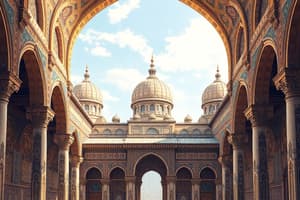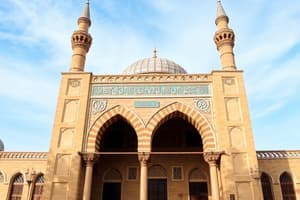Podcast
Questions and Answers
What materials are predominantly used in West Asiatic architecture due to their availability in the region?
What materials are predominantly used in West Asiatic architecture due to their availability in the region?
- Timber and colored limestones (correct)
- Brick and marble
- Clay and sandstone
- Concrete and steel
Which of the following civilizations is NOT mentioned as part of the four main civilizations in Persian architecture?
Which of the following civilizations is NOT mentioned as part of the four main civilizations in Persian architecture?
- Assyria
- Egypt (correct)
- Babylon
- Persia
How did the civilization located near the Tigris and Euphrates rivers adapt to the environmental challenge of flooding?
How did the civilization located near the Tigris and Euphrates rivers adapt to the environmental challenge of flooding?
- By building floating structures
- By positioning important structures on elevated platforms (correct)
- By constructing underground bunkers
- By relocating entirely to mountains
What is the primary reason for the scarcity of mud in the region referred to in West Asiatic architecture?
What is the primary reason for the scarcity of mud in the region referred to in West Asiatic architecture?
The term 'Fertile Crescent' refers to which of the following?
The term 'Fertile Crescent' refers to which of the following?
Which material utilized by lower echelons of society for construction is derived from mud?
Which material utilized by lower echelons of society for construction is derived from mud?
What is a characteristic feature of Persian architecture mentioned in the content?
What is a characteristic feature of Persian architecture mentioned in the content?
What type of bricks are similar to sun dried bricks and still mud-derived?
What type of bricks are similar to sun dried bricks and still mud-derived?
What was an early characteristic of courtyard architecture described in the content?
What was an early characteristic of courtyard architecture described in the content?
What common decorative element was used in Persian architecture to instill fear?
What common decorative element was used in Persian architecture to instill fear?
How is the clay used to make sun dried bricks sourced according to the content?
How is the clay used to make sun dried bricks sourced according to the content?
What is a typical use of the open courtyards in Persian architecture?
What is a typical use of the open courtyards in Persian architecture?
Which of the following is NOT primarily used in the construction of Assyrian and Babylonian architectures?
Which of the following is NOT primarily used in the construction of Assyrian and Babylonian architectures?
What is the primary advantage of kiln-dried bricks over sun-dried bricks?
What is the primary advantage of kiln-dried bricks over sun-dried bricks?
What was the significance of the ziggurat's height in Assyrian and Babylonian culture?
What was the significance of the ziggurat's height in Assyrian and Babylonian culture?
Which civilization is known for the development of polychrome or color glazed bricks?
Which civilization is known for the development of polychrome or color glazed bricks?
Which element was NOT commonly used as a pigment for colored glazed bricks?
Which element was NOT commonly used as a pigment for colored glazed bricks?
What was the chief building type in Nineveh after Babylon transferred the capital?
What was the chief building type in Nineveh after Babylon transferred the capital?
Who is credited with the majority of the construction of Persepolis?
Who is credited with the majority of the construction of Persepolis?
What was the most prestigious color used in the bricks and who had exclusive access to it?
What was the most prestigious color used in the bricks and who had exclusive access to it?
Which building is known as the 'grand audience hub' in the palace of Persepolis?
Which building is known as the 'grand audience hub' in the palace of Persepolis?
What role did the priests and kings play in relation to the ziggurat?
What role did the priests and kings play in relation to the ziggurat?
Which structure is often associated with the iconic representation of Babylon?
Which structure is often associated with the iconic representation of Babylon?
What was a common practice when Sumerians conquered a civilization?
What was a common practice when Sumerians conquered a civilization?
Which of the following structures is associated with King Nebuchadnezzar II?
Which of the following structures is associated with King Nebuchadnezzar II?
What was a characteristic feature of colored glazed bricks that made them expensive?
What was a characteristic feature of colored glazed bricks that made them expensive?
Which king is credited with the creation of the first written code of law?
Which king is credited with the creation of the first written code of law?
What architectural contribution is Sargon II known for?
What architectural contribution is Sargon II known for?
Which king is associated with moving the Assyrian capital to Nineveh?
Which king is associated with moving the Assyrian capital to Nineveh?
Which civilization is noted for its dynamic culture due to the integration of conquered states?
Which civilization is noted for its dynamic culture due to the integration of conquered states?
Which structure is often associated with King Hammurabi's legacy?
Which structure is often associated with King Hammurabi's legacy?
Flashcards are hidden until you start studying
Study Notes
Persian Architecture Overview
- Persian architecture is characterized by the use of timber and colored limestones, distinct due to the region's distance from the Tigris and Euphrates rivers.
- Located in a typically desert area, Persian architecture features open courtyards that connect structures, often utilizing cloth or drapery as partitions.
Mesopotamian Architecture
- Also known as West Asiatic or Mesopotamian architecture, it heavily relies on mud-derived materials and primarily developed near the Tigris and Euphrates rivers.
- The term "Fertile Crescent" describes the region around these rivers, indicating why early civilizations settled there, influenced by flooding.
- Key civilizations include Sumer (Iraq), Assyria (Northern Iraq/Southern Türkiye), Babylon (Iraq), and Persia (Iran).
Climatic Influence
- In Assyria and Babylon, architectural strategies were developed to combat flooding, such as constructing important structures on platforms (e.g., Ziggurats).
- The Persian strategy deviates, favoring open courtyards over elevated structures due to the region's arid conditions.
Construction Materials
- Sun-Dried Bricks: Used by lower social classes; made from mud collected from rivers and dried in the sun.
- Kiln-Dried Bricks: Utilized by wealthier classes; created by firing mud bricks in a kiln, resulting in stronger structures.
- Colored Glazed Bricks: High-gloss bricks made with natural and synthetic pigments (including unusual sources like urine and blood). Purple dye, a rare color derived from snails, was exclusively reserved for royalty.
Historical Influences
- King Nebuchadnezzar II: Noted for monumental constructions including the Great Palace of Nebuchadnezzar, Ishtar Gate, and the Hanging Gardens of Babylon.
- King Hammurabi: Established the Hammurabi Code, one of the first written legal codes, reflecting the intersection of architecture and governance.
- Sargon II: First ruler associated with palace construction in the ancient world, including the Palace of Sargon in Khorsabad.
- Sennacherib: Moved the Assyrian capital to Nineveh, emphasizing the importance of palatial architecture.
- Cyrus the Great: Recognized as the father of the Iranian nation, influencing Persian architecture.
- Darius I: Commissioned the elaborate Palace of Persepolis, featuring significant structures like the Tachara and Apadana.
- Xerxes I: Continued the construction of Persepolis, building notable sections such as the Gate of All Nations and the Hall of Hundred Columns.
Architectural Elements
- Famous structures such as Ziggurats served both religious and civic purposes, often symbolizing a connection to the divine by elevating temples closer to heaven.
- Scary iconography featuring winged bulls and monstrous designs adorned palace doorways, serving as deterrents against non-Persians.
Studying That Suits You
Use AI to generate personalized quizzes and flashcards to suit your learning preferences.




